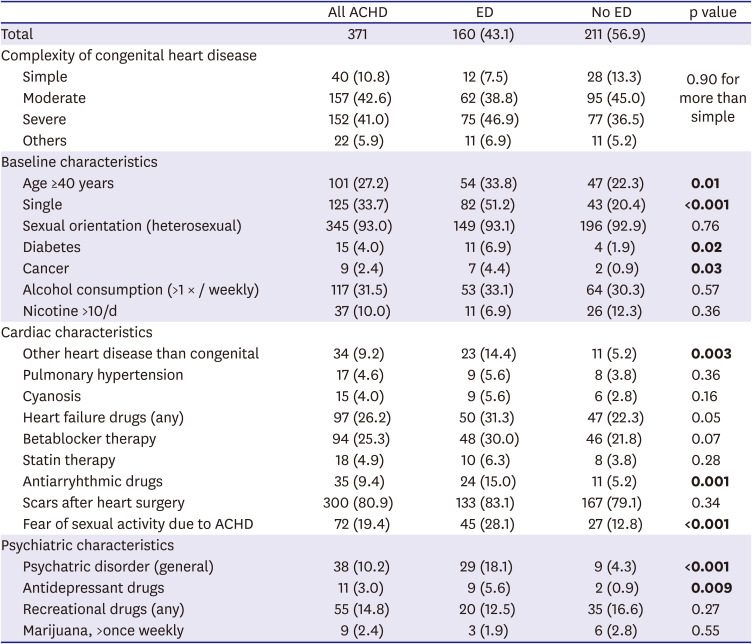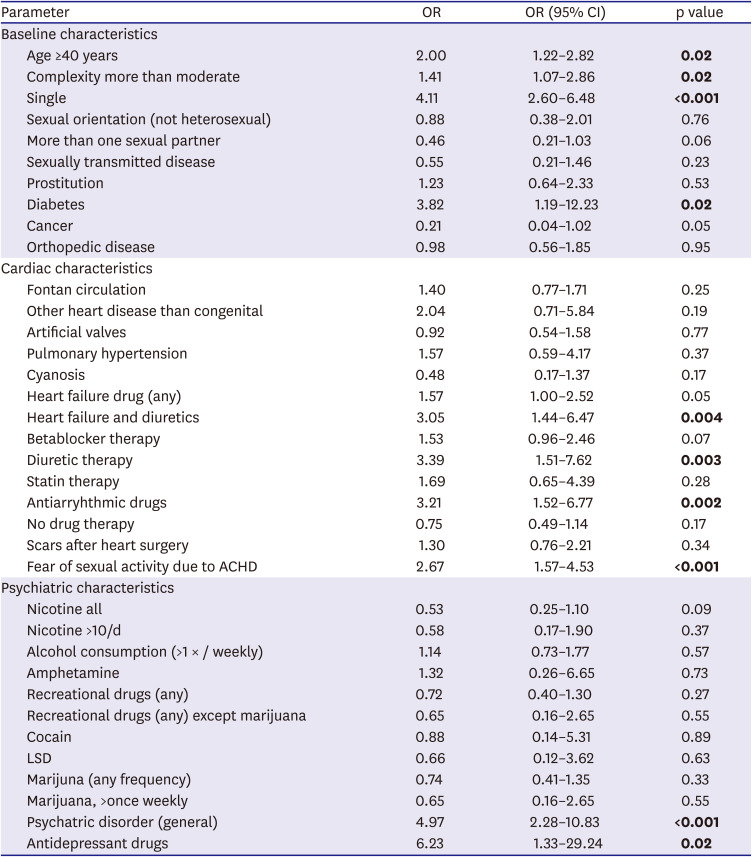1. Flynn KE, Lin L, Bruner DW, et al. Sexual satisfaction and the importance of sexual health to quality of life throughout the life course of U.S. adults. J Sex Med. 2016; 13:1642–1650. PMID:
27671968.

2. Nicolai MP, Both S, Liem SS, et al. Discussing sexual function in the cardiology practice. Clin Res Cardiol. 2013; 102:329–336. PMID:
23392531.

3. Khairy P, Ionescu-Ittu R, Mackie AS, Abrahamowicz M, Pilote L, Marelli AJ. Changing mortality in congenital heart disease. J Am Coll Cardiol. 2010; 56:1149–1157. PMID:
20863956.

4. Vigl M, Hager A, Bauer U, et al. Sexuality and subjective wellbeing in male patients with congenital heart disease. Heart. 2009; 95:1179–1183. PMID:
19364753.

5. Neiman A, Ginde S, Earing MG, Bartz PJ, Cohen S. The prevalence of sexual dysfunction and its association with quality of life in adults with congenital heart disease. Int J Cardiol. 2017; 228:953–957. PMID:
27912205.

6. Moons P, Van Deyk K, Marquet K, De Bleser L, Budts W, De Geest S. Sexual functioning and congenital heart disease: something to worry about? Int J Cardiol. 2007; 121:30–35. PMID:
17182130.

7. Kessler A, Sollie S, Challacombe B, Briggs K, Van Hemelrijck M. The global prevalence of erectile dysfunction: a review. BJU Int. 2019; 124:587–599.

8. Oechslin E, Kiowski W, Schindler R, Bernheim A, Julius B, Brunner-La Rocca HP. Systemic endothelial dysfunction in adults with cyanotic congenital heart disease. Circulation. 2005; 112:1106–1112. PMID:
16103236.

9. Diller GP, Dimopoulos K, Okonko D, et al. Exercise intolerance in adult congenital heart disease: comparative severity, correlates, and prognostic implication. Circulation. 2005; 112:828–835. PMID:
16061735.

10. Baumgartner H, De Backer J, Babu-Narayan SV, et al. 2020 ESC guidelines for the management of adult congenital heart disease: The Task Force for the Management of Adult Congenital Heart Disease of the European Society of Cardiology (ESC). Eur Heart J. 2021; 42:563–645. PMID:
32860028.
11. Stout KK, Daniels CJ, Aboulhosn JA, et al. 2018 AHA/ACC guideline for the management of adults with congenital heart disease: executive summary: a report of the American College of Cardiology/American Heart Association Task Force on Clinical Practice Guidelines. J Am Coll Cardiol. 2019; 73:1494–1563. PMID:
30121240.
12. Claes H, Opsomer RJ, Andrianne R, Vanbelle S, Albert A, Vanderdonck F. Characteristics and expectations of patients with erectile dysfunction: results of the SCORED study. Int J Impot Res. 2008; 20:418–424. PMID:
18418390.

13. Helm PC, Koerten MA, Abdul-Khaliq H, Baumgartner H, Kececioglu D, Bauer UM. Representativeness of the German National Register for Congenital Heart Defects: a clinically oriented analysis. Cardiol Young. 2016; 26:921–926. PMID:
26443325.

14. Rosen RC, Riley A, Wagner G, Osterloh IH, Kirkpatrick J, Mishra A. The international index of erectile function (IIEF): a multidimensional scale for assessment of erectile dysfunction. Urology. 1997; 49:822–830. PMID:
9187685.

15. Cappelleri JC, Rosen RC, Smith MD, Mishra A, Osterloh IH. Diagnostic evaluation of the erectile function domain of the International Index of Erectile Function. Urology. 1999; 54:346–351. PMID:
10443736.

16. Webb GD, Williams RG. 32nd Bethesda Conference: “care of the adult with congenital heart disease. J Am Coll Cardiol. 2001; 37:1162–1165.

17. Mulhall JP, Luo X, Zou KH, Stecher V, Galaznik A. Relationship between age and erectile dysfunction diagnosis or treatment using real-world observational data in the USA. Int J Clin Pract. 2016; 70:1012–1018. PMID:
28032424.

18. Chew KK, Stuckey B, Bremner A, Earle C, Jamrozik K. Male erectile dysfunction: its prevalence in Western Australia and associated sociodemographic factors. J Sex Med. 2008; 5:60–69. PMID:
17645447.

19. Solomon H, Man JW, Jackson G. Erectile dysfunction and the cardiovascular patient: endothelial dysfunction is the common denominator. Heart. 2003; 89:251–253. PMID:
12591819.

20. Radke RM, Diller GP, Duck M, et al. Endothelial function in contemporary patients with repaired coarctation of aorta. Heart. 2014; 100:1696–1701. PMID:
25095828.

21. Silversides CK, Marelli A, Beauchesne L, et al. Canadian Cardiovascular Society 2009 Consensus Conference on the management of adults with congenital heart disease: executive summary. Can J Cardiol. 2010; 26:143–150. PMID:
20352134.

22. Chen CA, Liao SC, Wang JK, et al. Quality of life in adults with congenital heart disease: biopsychosocial determinants and sex-related differences. Heart. 2011; 97:38–43. PMID:
20978017.

23. Cameron A, Rosen RC, Swindle RW. Sexual and relationship characteristics among an internet-based sample of U.S. men with and without erectile dysfunction. J Sex Marital Ther. 2005; 31:229–242. PMID:
16020141.

24. Weber MF, Smith DP, O'Connell DL, et al. Risk factors for erectile dysfunction in a cohort of 108 477 Australian men. Med J Aust. 2013; 199:107–111. PMID:
23879509.

25. Andonian C, Beckmann J, Biber S, et al. Current research status on the psychological situation of adults with congenital heart disease. Cardiovasc Diagn Ther. 2018; 8:799–804. PMID:
30740327.

26. Dobs AS, Sarma PS, Guarnieri T, Griffith L. Testicular dysfunction with amiodarone use. J Am Coll Cardiol. 1991; 18:1328–1332. PMID:
1918711.

27. Gul M, Carvajal A, Serefoglu EC, Minhas S, Salonia A. European association of urology guidelines for sexual and reproductive health 2020: What is new? Int J Impot Res. 2020; 32:477–479. PMID:
32683415.

28. Kaemmerer H, Gorenflo M, Huscher D, et al. Pulmonary hypertension in adults with congenital heart disease: real-world data from the international COMPERA-CHD registry. J Clin Med. 2020; 9:1456.








 PDF
PDF Citation
Citation Print
Print



 XML Download
XML Download